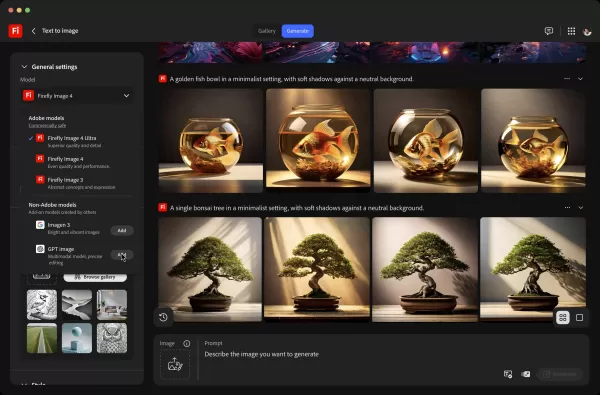Adobe adds more image generators to its growing AI family
Adobe Unveils Two New Generative AI Models Alongside Exciting Updates
Adobe has just unveiled two new iterations of its groundbreaking text-to-image generative AI model, Firefly Image, along with a slew of other exciting features across its Creative Cloud apps. This launch follows the footsteps of industry leaders like OpenAI and Google, offering users a dual-track approach to creativity—speed and efficiency versus depth and detail.
Meet Firefly Image Model 4
According to Adobe, Firefly Image Model 4 is the fastest, most controllable, and most realistic version of the Firefly series yet. It empowers creators to produce images in up to 2K resolution, with enhanced control over factors such as style, format sizes, and camera angles. The improvements over its predecessor focus on delivering high-quality outputs swiftly and efficiently. For projects requiring greater detail and realism, Adobe has introduced Firefly Image Model 4 Ultra. This advanced model excels at rendering intricate scenes with small structural elements, ensuring every element shines with clarity.
Impressive Examples
Take a look at these captivating AI-generated images—a child, flowers, and a tiger—that showcase the capabilities of the new models. While the child’s face does have slightly odd shadowing, the overall quality remains stunning. Adobe hasn’t disclosed which specific models were used for these examples, but they demonstrate immense potential.

Image: Adobe
Firefly Web App Gets a Boost
The Firefly web app is now home to not only the new image models but also Adobe’s text-to-video and text-to-vector models, both previously released in public beta. A brand-new addition today is Firefly Boards, a collaborative generative AI moodboarding app reminiscent of FigJam. It was initially teased as “Project Concept” during Adobe’s Max event in October. Additionally, Adobe promises a Firefly mobile app for iOS and Android is on the horizon.
Opening Up Third-Party Options
For those eager to explore beyond Adobe’s ecosystem, the Firefly web app now supports third-party AI models. Users can choose from options like OpenAI’s GPT image model or Google’s Imagen 3 for images, and Google’s Veo 2 for video. Support for additional platforms like Luma, Pika, Runway, fal.ai, and Ideogram is slated to arrive soon. However, Adobe emphasizes these third-party models are intended for experimentation rather than professional use, distinguishing its own offerings as “commercially safe.” Given Adobe’s reliance on public or licensed content, this distinction makes sense compared to competitors who lack similar assurances.

Image: Adobe
Updates Across Creative Cloud Apps
Adobe isn’t stopping at AI innovations. Its popular Creative Cloud apps are getting refreshed too. Illustrator’s generative shape fill and text-to-pattern tools are now fully available following their beta debut last year. In Photoshop, users can expect streamlined color adjustments and automatic selections for hair, clothing, and facial features. The Actions panel is also receiving a makeover, offering tailored editing suggestions based on individual styles. This update lays the groundwork for Adobe’s upcoming creative AI agent, set to integrate seamlessly into Photoshop’s editing capabilities.
Related article
 Trump Prioritizes AI Growth Over Regulation in Race to Outpace China
The Trump administration unveiled its landmark AI Action Plan on Wednesday, marking a decisive break from the Biden administration's risk-averse AI policies. The ambitious blueprint prioritizes aggressive infrastructure development, sweeping regulato
Trump Prioritizes AI Growth Over Regulation in Race to Outpace China
The Trump administration unveiled its landmark AI Action Plan on Wednesday, marking a decisive break from the Biden administration's risk-averse AI policies. The ambitious blueprint prioritizes aggressive infrastructure development, sweeping regulato
 YouTube Integrates Veo 3 AI Video Tool Directly Into Shorts Platform
YouTube Shorts to Feature Veo 3 AI Video Model This SummerYouTube CEO Neal Mohan revealed during his Cannes Lions keynote that the platform's cutting-edge Veo 3 AI video generation technology will debut on YouTube Shorts later this summer. This follo
YouTube Integrates Veo 3 AI Video Tool Directly Into Shorts Platform
YouTube Shorts to Feature Veo 3 AI Video Model This SummerYouTube CEO Neal Mohan revealed during his Cannes Lions keynote that the platform's cutting-edge Veo 3 AI video generation technology will debut on YouTube Shorts later this summer. This follo
 Microsoft Teases Budget-Friendly Xbox Cloud Gaming Subscription
Microsoft Explores Affordable Options for Xbox Cloud GamingNew developments suggest Microsoft is moving forward with plans to make Xbox Cloud Gaming more budget-friendly. Following earlier reports about a potential free ad-supported version, company
Comments (0)
0/200
Microsoft Teases Budget-Friendly Xbox Cloud Gaming Subscription
Microsoft Explores Affordable Options for Xbox Cloud GamingNew developments suggest Microsoft is moving forward with plans to make Xbox Cloud Gaming more budget-friendly. Following earlier reports about a potential free ad-supported version, company
Comments (0)
0/200
Adobe Unveils Two New Generative AI Models Alongside Exciting Updates
Adobe has just unveiled two new iterations of its groundbreaking text-to-image generative AI model, Firefly Image, along with a slew of other exciting features across its Creative Cloud apps. This launch follows the footsteps of industry leaders like OpenAI and Google, offering users a dual-track approach to creativity—speed and efficiency versus depth and detail.
Meet Firefly Image Model 4
According to Adobe, Firefly Image Model 4 is the fastest, most controllable, and most realistic version of the Firefly series yet. It empowers creators to produce images in up to 2K resolution, with enhanced control over factors such as style, format sizes, and camera angles. The improvements over its predecessor focus on delivering high-quality outputs swiftly and efficiently. For projects requiring greater detail and realism, Adobe has introduced Firefly Image Model 4 Ultra. This advanced model excels at rendering intricate scenes with small structural elements, ensuring every element shines with clarity.
Impressive Examples
Take a look at these captivating AI-generated images—a child, flowers, and a tiger—that showcase the capabilities of the new models. While the child’s face does have slightly odd shadowing, the overall quality remains stunning. Adobe hasn’t disclosed which specific models were used for these examples, but they demonstrate immense potential.

Image: Adobe
Firefly Web App Gets a Boost
The Firefly web app is now home to not only the new image models but also Adobe’s text-to-video and text-to-vector models, both previously released in public beta. A brand-new addition today is Firefly Boards, a collaborative generative AI moodboarding app reminiscent of FigJam. It was initially teased as “Project Concept” during Adobe’s Max event in October. Additionally, Adobe promises a Firefly mobile app for iOS and Android is on the horizon.
Opening Up Third-Party Options
For those eager to explore beyond Adobe’s ecosystem, the Firefly web app now supports third-party AI models. Users can choose from options like OpenAI’s GPT image model or Google’s Imagen 3 for images, and Google’s Veo 2 for video. Support for additional platforms like Luma, Pika, Runway, fal.ai, and Ideogram is slated to arrive soon. However, Adobe emphasizes these third-party models are intended for experimentation rather than professional use, distinguishing its own offerings as “commercially safe.” Given Adobe’s reliance on public or licensed content, this distinction makes sense compared to competitors who lack similar assurances.

Image: Adobe
Updates Across Creative Cloud Apps
Adobe isn’t stopping at AI innovations. Its popular Creative Cloud apps are getting refreshed too. Illustrator’s generative shape fill and text-to-pattern tools are now fully available following their beta debut last year. In Photoshop, users can expect streamlined color adjustments and automatic selections for hair, clothing, and facial features. The Actions panel is also receiving a makeover, offering tailored editing suggestions based on individual styles. This update lays the groundwork for Adobe’s upcoming creative AI agent, set to integrate seamlessly into Photoshop’s editing capabilities.
 Trump Prioritizes AI Growth Over Regulation in Race to Outpace China
The Trump administration unveiled its landmark AI Action Plan on Wednesday, marking a decisive break from the Biden administration's risk-averse AI policies. The ambitious blueprint prioritizes aggressive infrastructure development, sweeping regulato
Trump Prioritizes AI Growth Over Regulation in Race to Outpace China
The Trump administration unveiled its landmark AI Action Plan on Wednesday, marking a decisive break from the Biden administration's risk-averse AI policies. The ambitious blueprint prioritizes aggressive infrastructure development, sweeping regulato
 YouTube Integrates Veo 3 AI Video Tool Directly Into Shorts Platform
YouTube Shorts to Feature Veo 3 AI Video Model This SummerYouTube CEO Neal Mohan revealed during his Cannes Lions keynote that the platform's cutting-edge Veo 3 AI video generation technology will debut on YouTube Shorts later this summer. This follo
YouTube Integrates Veo 3 AI Video Tool Directly Into Shorts Platform
YouTube Shorts to Feature Veo 3 AI Video Model This SummerYouTube CEO Neal Mohan revealed during his Cannes Lions keynote that the platform's cutting-edge Veo 3 AI video generation technology will debut on YouTube Shorts later this summer. This follo
 Microsoft Teases Budget-Friendly Xbox Cloud Gaming Subscription
Microsoft Explores Affordable Options for Xbox Cloud GamingNew developments suggest Microsoft is moving forward with plans to make Xbox Cloud Gaming more budget-friendly. Following earlier reports about a potential free ad-supported version, company
Microsoft Teases Budget-Friendly Xbox Cloud Gaming Subscription
Microsoft Explores Affordable Options for Xbox Cloud GamingNew developments suggest Microsoft is moving forward with plans to make Xbox Cloud Gaming more budget-friendly. Following earlier reports about a potential free ad-supported version, company





























